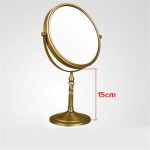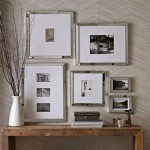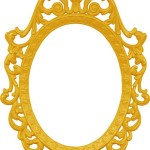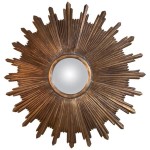```html
The Allure of Large Baroque Mirrors in Gold
Large Baroque mirrors in gold represent a significant statement in interior design, blending historical grandeur with contemporary aesthetics. These mirrors are not merely reflective surfaces; they function as focal points, architectural enhancements, and sources of ambient light. Understanding their history, design characteristics, and practical applications is crucial for appreciating their enduring appeal.
The Baroque period, flourishing from the early 17th to the mid-18th century, was characterized by elaborate ornamentation, dramatic contrasts, and a sense of grandeur. This artistic movement extended beyond painting and sculpture to encompass architecture, furniture design, and decorative arts. Mirrors, previously simple and utilitarian, became opulent displays of craftsmanship and wealth. The association of mirrors with status and prestige during this period is intrinsic to their enduring value and desirability.
Gold, as a precious metal, further elevates the Baroque mirror. Its inherent luster and association with royalty and divinity have long cemented its place as a symbol of luxury. When applied to the intricate carvings and flourishes characteristic of Baroque design, gold enhances the visual impact and creates a sense of unparalleled richness.
Historical Context and Evolution
The emergence of the Baroque style was closely tied to the Catholic Church's Counter-Reformation, seeking to reassert its influence through visually compelling art. Baroque art aimed to inspire awe and wonder, captivating the senses and drawing viewers into a state of spiritual contemplation. This emphasis on grandeur resonated in all aspects of artistic expression, including the design of mirrors.
Early Baroque mirrors were often smaller and incorporated into elaborate frames that were as much a work of art as the reflected image itself. As glassmaking technology improved, larger sheets of glass became available, leading to the creation of more imposing and dramatic mirrors. These large-scale mirrors were typically commissioned by wealthy patrons, including royalty, nobility, and high-ranking members of the clergy. The mirrors were often placed in grand halls, ballrooms, and drawing rooms to reflect candlelight and amplify the sense of space.
The guild system played a significant role in the production of Baroque mirrors. Highly skilled artisans, including wood carvers, gilders, and glassmakers, collaborated to create these intricate masterpieces. The guilds ensured a consistent standard of quality and protected the trade secrets passed down through generations. The craftsmanship displayed in these historical mirrors is a testament to the dedication and expertise of these artisans.
Over time, the Baroque style evolved, giving rise to variations such as Rococo. While Rococo retained the emphasis on ornamentation, it incorporated lighter, more asymmetrical designs and a pastel color palette. Although Rococo mirrors often featured gold accents, the overall aesthetic was less overtly opulent than that of the earlier Baroque period. Nonetheless, the legacy of the Baroque mirror continued to influence subsequent design movements, ensuring its enduring presence in the world of decorative arts.
Key Design Characteristics of Large Baroque Mirrors in Gold
Several defining features characterize large Baroque mirrors in gold, setting them apart from other styles. These features contribute to their overall visual impact and historical authenticity.
Firstly, the frame is typically the most prominent element. It is usually crafted from wood, chosen for its ability to be intricately carved and gilded. Common motifs include acanthus leaves, scrolls, shells, and floral patterns. These details are often deeply carved, creating a three-dimensional effect that enhances the play of light and shadow.
Secondly, the gilding process is crucial to the aesthetic of a Baroque mirror. Gilding involves applying thin layers of gold leaf to the wood surface, creating a lustrous and reflective finish. The process is often multi-layered, with different tones of gold used to highlight specific details and add depth and complexity. The aging process naturally affects the gold leaf, creating a patina that adds to the mirror's antique charm.
Thirdly, the size of the mirror is a significant factor. Large Baroque mirrors are designed to command attention and create a sense of grandeur. Their imposing scale allows them to reflect a significant portion of the surrounding space, making them ideal for enhancing the sense of spaciousness in a room. A large mirror can also serve as a focal point, drawing the eye and establishing a sense of balance and proportion.
Fourthly, the shape of the mirror frame contributes to its overall design. Common shapes include rectangular, oval, and arched designs. The frame may be symmetrical or asymmetrical, depending on the specific style and period. The shape of the frame often complements the architectural features of the room in which the mirror is placed.
Finally, the use of other decorative elements, such as cherubs, masks, and cartouches, is characteristic of Baroque mirrors. These elements further enhance the ornate and dramatic aesthetic. They contribute to the mirror's storytelling potential, conveying a sense of history and cultural significance.
Practical Applications and Interior Design Considerations
Large Baroque mirrors in gold offer a versatile range of applications in interior design, capable of transforming spaces both aesthetically and functionally.
One of the primary benefits of using a large mirror is its ability to enhance the sense of space. By reflecting light and creating the illusion of depth, a large mirror can make a small room feel larger and more open. This is particularly useful in rooms with limited natural light or in areas where space is at a premium.
Another key application is as a focal point. In a grand foyer, a large Baroque mirror can serve as a stunning centerpiece, welcoming guests and setting the tone for the rest of the home. In a living room, it can be positioned above a fireplace or console table to create a dramatic statement. In a bedroom, it can be placed on a dressing table or wall to add a touch of elegance and glamour.
Large mirrors also contribute significantly to the ambient lighting. By reflecting both natural and artificial light, they can brighten up a room and reduce the need for artificial lighting. This can help to create a more inviting and comfortable atmosphere. Placing a mirror strategically near a window or light source can maximize its reflective potential.
When incorporating a large Baroque mirror into an interior design scheme, it's important to consider the style of the room. While Baroque mirrors are traditionally associated with formal and opulent settings, they can also be successfully integrated into more contemporary spaces. The key is to balance the mirror's ornate design with the surrounding elements. For example, pairing a Baroque mirror with minimalist furniture and a neutral color palette can create a striking contrast that highlights the mirror's sculptural qualities.
Furthermore, the placement of the mirror should be carefully considered. Avoid placing it in direct sunlight, as this can cause the glass to overheat and potentially damage the frame. Ensure that the mirror is securely mounted to the wall to prevent accidents. Consider the viewing angle and the reflections that will be visible in the mirror. Ideally, the mirror should reflect something aesthetically pleasing, such as a garden view or a piece of art.
Finally, it's important to maintain the mirror properly to ensure its longevity and beauty. Regularly clean the glass with a soft cloth and a mild glass cleaner. Avoid using abrasive cleaners, as these can scratch the surface. Dust the frame regularly with a soft brush to prevent the accumulation of dust and dirt. If the gold leaf becomes damaged, consult a professional gilder for repairs.
The enduring appeal of large Baroque mirrors in gold lies not only in their aesthetic grandeur but also in their ability to transform spaces and enhance the quality of light. By understanding their historical context, design characteristics, and practical applications, individuals can appreciate the timeless elegance and enduring value of these exceptional pieces of decorative art.
```
Large Ornate Gold Baroque Frame Mirror 24 X 36 Hamilton Hills

Extra Large Full Length Gold Rococo Dress Mirror Big Vintage Victorian Mirrors

Oversized Full Length Mirror Antique Gold Handmade French Era Inspired 19th Century Design Stand Alone Show Stopper

Top Gold Baroque Wall Mirror Hamilton Hills

French Mirror 1 In Stock 7 Feet Tall Baroque Rococo Antique Vintage Gold Leaf Furniture Interior Design

Ornate Antique Gold Wall Mirror Large Decor Glass Mirrors Home Gifts Art Interior Gift Wood Frame

Hamilton Hills 30x40 Gold Baroque Mirror Antique French Wall Decor 30 X 40 Kroger

Large Baroque Rococo Mirror Full Length Antique Gold Leaf Made In Italy French Carved Frame Victorian Home Decor 8067

Large Classic Baroque Mirror 17th Century Antique Italian Silver Leaf Made In Italy Full Length Victorian Home Style Item 8064

An Exceptional Large Baroque Mirror Iliad








